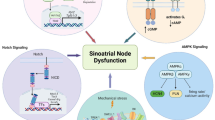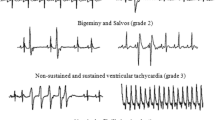Abstract
Disturbance of cardiac rhythm is one of the consequences of myocardial ischemia/reperfusion injury. Many researchers have prompted considerable interests in developing therapeutic approaches for its control. In present study, we want to determine whether that adenosine pre- and postconditioning have protective effects on sinoatrial node ischemia/reperfusion injury on morphology, arrhythmia score, serological markers (CK-MB and cTnT), SOD activities, MDA levels and expression of HCN4 channels in SA node cells. According to the arrhythmia score recorded, whether adenosine used in terms of ischemia or reperfusion, the total number of arrhythmia was significantly reduced, as well as the number of its episodes was also markedly decreased. We have also shown a clear correlation between HCN4 channels expression and the dysfunction of SA node cells. HCN4 immunoreactivity decreased after adenosine pre- and postconditioning, but changes were significantly smaller in the cells of the SA node compared with cells of I/R group. The content of cTnT, CK-MB and MDA in adenosine pre- and postconditioning group reduced significantly; but the level of SOD increased significantly. Histological examination and electron microscopy observations found in adenosine pre- and postconditioning group sinoatrial node injury also mitigated. These findings suggested that adenosine pre- or postconditioning were to reduce the incidence of ischemia/reperfusion arrhythmias, reduce myocardial ischemia reperfusion injury. The mechanism was to stabilize the SA node cells membrane and one possible mechanism involves modulation of HCN4 channels in pacemaker cells of the sinoatrial node.





Similar content being viewed by others
References
Saeki K, Obi I, Ogiku N, Shigekawa M, Imagawa T, Matsumoto T (2002) Cardioprotective effects of 9-hydroxyellipticine on ischemia and reperfusion in isolated rat heart. Jpn J Pharmacol 89(1):21–28
Robinson LA, Braimbridge MV, Hearse DJ (1984) Creatine phosphate: an additive myocardial protective and antiarrhythmic agent in cardioplegia. J Thorac Cardiovasc Surg 87(2):190–200
Aranki SF, Shaw DP, Adams DH, Rizzo RJ, Couper GS, VanderVliet M, Collins JJ Jr, Cohn LH, Burstin HR (1996) Predictors of atrial fibrillation after coronary artery surgery: current trends and impact on hospital resources. Circulation 949(3):390–397
Goldberg S, Greenspon AJ, Urban PL, Muza B, Berger B, Walinsky P, Maroko PR (1983) Reperfusion arrhythmia: a marker of restoration of antegrade flow during intracoronary thrombolysis for acute myocardial infarction. Am Heart J 105(1):26–32
Jin ZQ, Zhang J, Huang Y, Hoover HE, Vessey DA, Karliner JS (2007) A sphingosine kinase 1 mutation sensitizes the myocardium to ischemia/reperfusion injury. Cardiovasc Res 76(1):41–50
Vessey DA, Li L, Kelley M, Zhang J, Karliner JS (2008) Sphingosine can pre- and postcondition heart and utilizes a different mechanism from sphingosine 1-phosphate. J Biochem Mol Toxicol 22(2):113–118
Brown HF, DiFrancisco D, Nobel SJ (1979) How does adrenaline accelerate the heart? Nature 280(5719):235–236
Brown HF, DiFrancesco D (1980) Voltage clamp investigation of current underlying pacemaker activity in rabbit sino-atrial node. J Physiol 308:331–351
DiFrancesco D (1981) A new interpretation of the pace-marker current in calf Purkinje fibers. J Physiol 314:359–376
Maltsev VA, Lakatta EG (2008) Dynamic interactions of an intracellular Ca2+ clock and membrane ion channel clock underlie robust initiation and regulation of cardiac pacemaker function. Cardiovasc Res 77(2):274–284
Ishii T, Takano M, Xie LH, Noma A, Ohmori H (1999) Molecular characterization of the hyperpolarization-activated cation channel in rabbit heart sinoatrial node. J Biol Chem 274(18):12835–12839
Shi W, Wymore R, Yu H, Wu J, Wymore RT, Pan Z, Robinson RB, Dixon JE, McKinnon D, Cohen IS (1999) Distribution and prevalence of hyperpolarization-activated cation channel (HCN) mRNA expression in cardiac tissues. Circ Res 85(1):e1–e6
Stillitano F, Lonardo G, Zicha S, Varro A, Cerbai E, Mugelli A, Nattel S (2008) Molecular basis of funny current (If) in normal and failing human heart. J Mol Cell Cardiol 45(2):289–299
Bolger AP, Sharma R, von Haehling S, Doehner W, Oliver B, Rauchhaus M, Coats AJ, Adcock IM, Anker SD (2002) Effect of interleukin-10 on the production of tumor necrosis factor alpha by peripheral blood mononuclear cells from patients with chronic heart failure. Am J Cardiol 90(4):384–389
Paulus K, Larissa F, Lisa F et al (2003) Altered sinus nodal and atrioventricular nodal function in freely moving mice overexpressing the A1 adenosine recept. Am J Physiol Heart Circ Physiol 285:H145–H153
Ke JJ, Wang YL, Li JG, Wu J, Feng XB (2004) Pretreatment of effective adenosine on activation of NF-kappaB and level of TNF-alpha during myocardial ischemia and reperfusion in rats. Chin J Traumatol 7(1):25–27
Curtis MJ (1998) Characterisation, utilisation and clinical relevance of isolated perfused heart models of ischaemia-induced ventricular fibrillation. Cardiovasc Res 39(1):194–215
Lei M, Jones SA, Liu J, Lancaster MK, Fung SS, Dobrzynski H et al (2004) Requirement of neuronal- and cardiac-type sodium channels for murine sinoatrial node pacemaking. J Physiol 559(Pt 3):835–848
Wells JE, Rowland KC, Proctor EK (2007) Hyperpolarization-activated channels in trigeminal ganglia innervating healthy and pulp-exposed teeth. Int Endod J 40(9):715–721
Hein M, Roehl AB, Baumert JH, Bantes B, Bleilevens C, Bernstein N, Steendijk P, Rossaint R (2008) Establishment of a porcine right ventricular infarction model for cardioprotective actions of xenon and isoflurane. Acta Anaesthesiol Scand 52(9):1194–1203
Du Toit EF, Muller CA, McCarthy J, Opie LH (1999) Levosimendan: effects of a calcium sensitizer on function and arrhythmias and cyclic nucleotide levels during ischemia/reperfusion in the Langendorff-perfused guinea pig heart. J Pharmacol Exp Ther 29(2):505–514
Rhodes SS, Ropella KM, Camara AKS, Chen Q, Riess ML, Pagel PS, Stowe DF (2006) Ischemia-reperfusion injury changes the dynamics of Ca21-contraction coupling due to inotropic drugs in isolated hearts. J Appl Physio 100(3):940–950
Jason NP, John PH (2007) Adenosinergic cardioprotection: multiple receptors, multiple pathways. Pharmacol Ther 114(2):208–221
Zhao ZQ, Vinten-Johansen J (2006) Postconditioning: reduction of reperfusion-induced injury. Cardiovasc Res 70(2):200–211
Bowers TR, O’Neill WW, Grines C, Pica MC, Safian RD, Goldstein JA (1998) Effect of reperfusion on biventricular function and survival after right ventricular infarction. N Engl J Med 338(14):933–940
Lu J, Zang WJ, Yu XJ, Jia B, Chorvatova A, Sun L (2006) Effects of postconditioning of adenosine and acetylcholine on the ischemic isolated rat ventricular myocytes. Eur J Pharmacol 549(1–3):133–139
Meester BJ, Shankley NP, Welsh NJ, Wood J, Meijler FL, Black JW (1998) Pharmacological classification of adenosine receptors in the sinoatrial and atrioventricular nodes of the guinea-pig. Br J Pharmacol 124(4):685–692
Stieber J, Herrmann S, Feil S, Loster J, Feil R, Biel M, Hofmann F, Ludwig A (2003) The hyperpolarization-activated channel HCN4 is required for the generation of pacemaker action potentials in the embryonic heart. Proc Natl Acad Sci USA 100(25):15235–15240
Berdeaux A (2007) Preclinical results with I(f) current inhibition by ivabradine. Drugs 67(Suppl 2):25–33
Sarre A, Pedretti S, Gardier S, Raddatz E (2010) Specific inhibition of HCN channels slows rhythm differently in atria, ventricle and outflow tract and stabilizes conduction in the anoxic-reoxygenated embryonic heart model. Pharmacol Res 61(1):85–91
Liu R, Xing J, Miao N, Li W, Liu W, Lai YQ, Luo Y, Ji B (2009) The myocardial protective effect of adenosine as an adjunct to intermittent blood cardioplegia during open heart surgery. Eur J Cardiothorac Surg 36(6):1018–1023
Acknowledgments
This work was supported by a Grant from Ministry of Health Foundation of Sichuan Province of China (20097464) and Nature and Science Foundation of Hubei Province of China (2008CDB208).
Author information
Authors and Affiliations
Corresponding author
Rights and permissions
About this article
Cite this article
Yu, FX., Ke, JJ., Fu, Y. et al. Protective effects of adenosine in rabbit sinoatrial node ischemia–reperfusion model in vivo: control of arrhythmia by hyperpolarization-activated cyclic nucleotide-gated (HCN)4 channels. Mol Biol Rep 38, 1723–1731 (2011). https://doi.org/10.1007/s11033-010-0286-9
Received:
Accepted:
Published:
Issue Date:
DOI: https://doi.org/10.1007/s11033-010-0286-9




